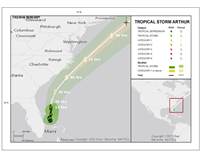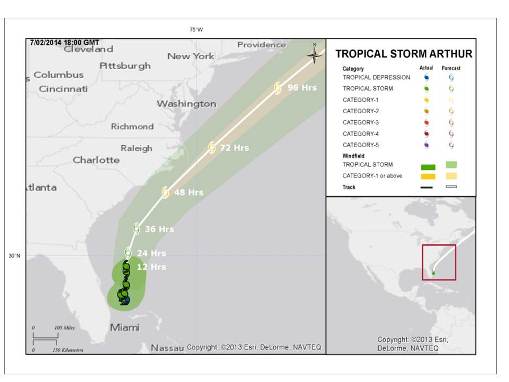

Event Summary
Tropical Storm Arthur, the first named storm of the 2014 Atlantic hurricane season, is expected to reach hurricane strength Thursday, according to the National Hurricane Center (NHC). Arthur is currently located 110 miles east-northeast of Cape Canaveral, Florida and 235 miles south of Charleston, South Carolina. The storm is moving north at seven miles per hour and is expected to turn toward the north-northeast Wednesday night. By Thursday, the storm is expected to turn toward the northeast with an increase in forward speed. The eye of Arthur is expected to pass east of Northeastern Florida tonight and move parallel to the coasts of South and North Carolina during the next 24 to 48 hours.
The NHC predicts Arthur will intensify to a Category 1 hurricane by Thursday as it skims the Outer Banks of North Carolina. As a result, a hurricane watch is in effect for Bogue Inlet to Oregon Inlet, North Carolina, as well as the Pamlico Sound. Tropical storm warnings have been issued from Little River Inlet, North Carolina to the North Carolina/Virginia border, including Pamlico and Eastern Albemarle Sounds.
 The right panel outlines the NHC cone of uncertainty. The left panel highlights areas potentially affected by the tropical storm winds based on the NHC best track. Be aware that tropical intensity can change under a very short timeframe and one should closely monitor NHC updates for their area of interest.
The right panel outlines the NHC cone of uncertainty. The left panel highlights areas potentially affected by the tropical storm winds based on the NHC best track. Be aware that tropical intensity can change under a very short timeframe and one should closely monitor NHC updates for their area of interest.
Hazard data illustrated in the CAT-i map was taken from i-aXs®, Guy Carpenter’s web-based risk management platform. i-aXs users can view impacted areas on any map as well as see how their portfolios were affected. Please contact your broker or GC Analytics® representative for assistance or go to www.i-axs.info for further information.
Due to the uncertainty in both track and intensity of the storm, landfall scenarios further west with direct impacts to the mainland are possible, as identified by the NHC cone of uncertainty.
Interests north of the warning area along the East Coast of the United States should monitor the progress of Arthur.
Meteorological Discussion
The presence of mid-level dry air is hampering the intensification of Arthur in the short-term. Given a favorable environment of warm water and weak wind shear as Arthur continues north, the storm should develop into a Category 1 hurricane within the next 48 hours.
According to the latest forecasts, Arthur will pass near or over the Outer Banks of North Carolina Thursday as a Category 1 hurricane, with three to five inches of rain and sustained winds of around 70 mph possible. The storm should move quickly up the Northeastern coast and be off the coast of New England by Friday, with a possibility of a landfall in Canada's Maritime Provinces by Saturday.
According to the Canadian Hurricane Centre, a trough of low pressure will be moving east from the Great Lakes, guiding the storm toward Atlantic Canada. The nature of the trough will affect Arthur's intensity and path, ranging from direct rain and wind to a storm well off-shore with some rain.
Hazards, Watches, Warnings
A hurricane watch has been issued from Bogue Inlet to Oregon Inlet, North Carolina, as well as for the areas surrounding the Pamlico Sound. Hurricane conditions are possible within the watch area by Thursday night. Any deviation of the forecast track to the left or an increase in the forecast size would likely require the issuance of hurricane warnings for all or part of the hurricane watch area.
A tropical storm warning has been issued from Little River Inlet, North Carolina to the North Carolina/Virginia border, including Pamlico and Eastern Albemarle Sounds. Tropical storm conditions are expected within the warning area by Thursday evening. A tropical storm watch is also in effect for the area south of Little River Inlet to South Santee River, South Carolina. Tropical storm conditions are possible within the watch area by Thursday afternoon.
The combination of a dangerous storm surge and the tide will cause areas near the coast to be flooded by rising water. Surge-related flooding will depend on the timing of the surge and the tidal cycle, but can vary greatly over short distances. If the peak surge occurs at the time of high tide, the coast of North Carolina could see a surge of two to four feet. Immediate coastal areas of onshore flow will experience the highest water levels.
Arthur is expected to produce rainfall accumulations of one to two inches, and up to four inches, across the Eastern Florida Peninsula and over coastal areas of North Carolina through Thursday.
Impacts
Minor damage to roof coverings and wall cladding from Category 1 hurricane winds is possible for single-family residential homes in the affected area. Damage from downed trees will be another concern, as soils will likely be saturated from recent heavy rainfall. Weaker structures such as mobile homes and light metal structures could experience some structural damage. Engineered structures such as reinforced concrete and steel buildings should experience very little damage. However, isolated cases of damage to non-structural elements such as windows, cladding and roof coverings are possible.
Sources: Reuters, Associated Press, U.S. National Weather Service, U.S. Storm Prediction Center, Canadian Hurricane Centre, AIR Worldwide
Guy Carpenter publishes CAT-i reports for major natural catastrophes worldwide. These reports cover catastrophes including worldwide tropical cyclones, earthquakes, major UK and European floods and any other natural event that is likely to incur a significant loss to the (re)insurance industry. Please email CAT.i@guycarp.com if you wish to be added to the free email distribution list.
Guy Carpenter compiles RISK-i reports for major technological or man-made events worldwide. These reports cover risks to property, transport and life including explosions, fires, crashes, engineering disasters and terrorist attacks that are likely to incur a significant loss to the (re)insurance industry. Please email RISK.i@guycarp.com if you wish to be added to the free email distribution list..